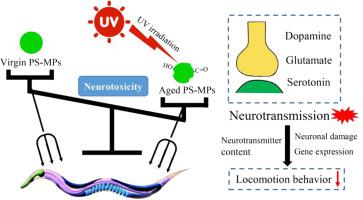Journal of Hazardous Materials ( IF 12.2 ) Pub Date : 2021-06-24 , DOI: 10.1016/j.jhazmat.2021.126482 Haibo Chen 1 , Xin Hua 2 , Yue Yang 3 , Chen Wang 4 , Lide Jin 4 , Chenyin Dong 2 , Zhaofeng Chang 2 , Ping Ding 2 , Mingdeng Xiang 2 , Hui Li 4 , Yunjiang Yu 2

|
Microplastics are ubiquitous in all environments and exert toxic effects in various organisms. However, the neurotoxicity and underlying mechanisms of long-term exposure to MPs aged under UV radiation remain largely unclear. In this study, Caenorhabditis elegans was treated with 0.1–100 μg/L virgin and aged polystyrene microplastics (PS-MPs) for 10 d, with locomotion behavior, neuronal development, neurotransmitter content, and neurotransmission-related to gene expression as endpoints. Using locomotion behavior as an endpoint, chronic exposure to aged PS-MPs at low concentrations (1 μg/L) caused more severe neurotoxicity than that to virgin PS-MPs. In transgenic nematodes, exposure to 10–100 μg/L aged PS-MPs significantly influenced the fluorescence intensity and percentage of worms with neurodegeneration of dopaminergic, glutamatergic, and serotonergic neurons compared with control. Further investigations showed that the content of glutamate, serotonin, and dopamine was significantly influenced in nematodes chronically exposed to 100 μg/L of aged PS-MPs. Similarly, neurotransmission-related gene (e.g., eat-4, dat-1, and tph-1) expression was also altered in nematodes. These results indicate that aged PS-MPs exert neurotoxicity owing to their effects on dopamine, glutamate, and serotonin neurotransmission. This study provides insights into the underlying mechanisms and potential risks of PS-MPs after UV radiation.
中文翻译:

长期暴露于紫外线老化的微塑料通过影响秀丽隐杆线虫的多巴胺、谷氨酸和血清素神经传递诱导神经毒性
微塑料在所有环境中无处不在,并对各种生物产生毒性作用。然而,长期暴露于紫外线辐射下老化的 MP 的神经毒性和潜在机制仍不清楚。在这项研究中,秀丽隐杆线虫用 0.1–100 μg/L 原始和老化聚苯乙烯微塑料 (PS-MPs) 处理 10 天,以运动行为、神经元发育、神经递质含量和与基因表达相关的神经传递作为终点。以运动行为为终点,长期暴露于低浓度 (1 μg/L) 的老化 PS-MP 会导致比原始 PS-MP 更严重的神经毒性。在转基因线虫中,与对照相比,暴露于 10-100 μg/L 的老化 PS-MP 显着影响了具有多巴胺能、谷氨酸能和血清素能神经元神经变性的蠕虫的荧光强度和百分比。进一步的研究表明,长期暴露于 100 μg/L 的老化 PS-MP 的线虫的谷氨酸、5-羟色胺和多巴胺的含量受到显着影响。类似地,神经传递相关基因(例如,线虫中的eat-4、dat-1和tph-1 )表达也发生了改变。这些结果表明,老化的 PS-MP 由于对多巴胺、谷氨酸和血清素神经传递的影响而产生神经毒性。这项研究提供了对紫外线辐射后 PS-MP 的潜在机制和潜在风险的见解。










































 京公网安备 11010802027423号
京公网安备 11010802027423号